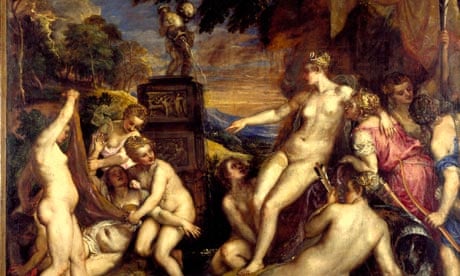If Sophie Dahl is still smarting from the derision that followed her appeal on behalf of her grandfather's writing hut – with his manky bottled hipbone just exactly where he left it – the public response to the news that a Titian has been bought for the nation might offer some consolation. Unlike the Titian, Ms Dahl will note, the importance of the ancestral hut, which requires a £500,000 renovation, was hardly disputed.
Admittedly, the comparison is inexact: Titian never had the good fortune to live in Great Missenden. He cannot at this distance be accounted much of a lovable eccentric, nor does the story of Diana and Callisto come near to Charlie and the Chocolate Factory for humour, incident and cautionary effect. Moreover, while Sophie was chugging for Dahl-aid, the English and Scottish National Galleries did not make a public case for raising the Duke of Sutherland's £45m, anticipating – correctly – that the times are not propitious.
But to look at the overwhelmingly hostile online response to the National Gallery's use of its funds to secure, in Diana and Callisto, not a crumbling hut, but the acclaimed pair to an existing old master that will — unlike the Dahl museum (adult entry £6) – be available for everyone to see, you would think the directors had snatched the picture money from orphans or from the beseeching hooves of piteous, starving donkeys, prior to blowing it all on a Banksy or, worse, a foreign Banksy.
"It's not as if it's Jock McTitian," the Glasgow MP, Ian Davidson, has pointed out. The Titians are evidently still well dodgy after being in Britain over 200 years and on public view since 1945. In these circumstances, the Ashmolean Museum, which has chosen this inopportune moment to solicit donations for a £8m, privately owned Manet – not as if it's Jock McImpressionist – may soon find itself the museum equivalent of a Romanian Big Issue seller. Eclipsing quibbles about Titian's foreignness and technique and abundant contempt for the painting's seller, the predominant emotion in debates on the BBC, Independent and Guardian websites – places where spending on culture is hardly, de facto, an absurdity – has been fury that the National Gallery should consider fine art a priority at a time of cuts and hardship.
That no monkey with a paintbrush could have painted Diana and Callisto cannot redeem Titian in a climate when any arts spending, new or old, may be interpreted as a preening, callous snub, eg: "How can canvas with some oil on it really be worth 45 MILLION pounds! How many doctors and nurses is that?"
It probably depends on the nurse or doctor, but if the comparison has to be in public money, the sum could readily be converted into unwanted swine flu vaccine (£150m) or BBC 3 (£115m) or bonuses at the state-owned bank, RBS (£785m) or the Olympics (£9bn).
But as the National Gallery has attempted to stress, it avoided, by not appealing to the public, diverting funds from the poor. Money for the latest Titian was raised principally from living benefactors and historic donations that constitute the gallery's reserves, which the director now describes as "depleted". None the less, as opponents of this purchase have pointed out, a contribution of £3m came from the Heritage Lottery Fund, courtesy of the very social classes who are still, notwithstanding free entry, least likely to visit the national art galleries.
"These sumptuous late great works of Titian bring joy and pleasure to all," says Antony Gormley. But in particular, it appears, they bring pleasure to the more affluent social groups whose repeat visits are thought to account for much of the huge increase in visitor numbers since Labour abolished entry fees. Moreover, if the response to the Titians is any guide, a decade of free entry has yet to eradicate a perception that these galleries serve an elite and spend money in ways that must look comically indulgent to anyone struggling to survive. You wonder, in fact, if the new acquisition might have looked more appealing, in this pinched climate, had it been subsidised, in place of lottery players, by those who can afford to pay, occasionally, for their repeat visits in the way they already do to see oversubscribed Hockney and Leonardo blockbusters.
Alternatively, if some of the Titian money came from a tourist precept rather than a gamblers' one, the transaction might look less offensive to its critics. Walking freely into London's tourist-crammed galleries, you can feel as nettled by this difference from every other capital city (even those in Scandinavia that are populated exclusively by our highly taxed social-democratic mentors) as proud of the unique, British offer of free access, which has acquired, for some reason, a sanctity that combines, to the point of abolishing any discussion of fairness, the NHS's "free at the point of use" principle with the growing, internet-bred conviction that only idiots pay.
Perhaps inevitably, the most prominent supporters of free entry and the brilliant way it allows one repeatedly to "pop in" often seem to be the people who, along with the opportunity for all this popping, evidently have the means to pay for it. The latest attack on entry fees (for the blockbuster exhibitions) came, risibly, from Charles Saatchi. Unlike child benefit, trust funds, other universal benefits from the fat years, this particular entitlement, subsidised by lottery and scratchcard players, remains, as Tristram Hunt discovered, when he proposed, in fairness to council-run museums, the resumption of entry fees, too precious a shibboleth to adjust by so much as the cost of a phone app, a swim or a National Gallery latte.
Last year, Brian Sewell – a former enthusiast for free admission – estimated that just a £1 entry fee, while money is short, could pay, in one year for a Titian "and probably a major exhibition in every institution". Assuming, anyway, the payment of a nominal sum, the guarantee of some free days and the exemption, as in Paris, of nationals under 26 and benefit claimants, how is this funding more outrageous than charging families to visit other cultural destinations, no less owned by "us", from the Tower of London, the royal palaces and Stonehenge, to Kew Gardens, English Heritage's mansions and ruins, the National theatre and that temple of open access, the Royal Opera House? Not forgetting, of course, the great collection of Olympic, soon to be completely worthless, stadia in which any patriot lucky enough to win the ticket lottery will pay up to £725 for "premium events" (no concessions).
It is partly, no doubt, because of fears of what Cameron's terrifyingly philistine government might do to museums, once it has trashed the libraries and finished counselling the film industry, that free access to museums has become totemic, even when budgets have been slashed, hours are being cut and the cost of a masterpiece is counted, bitterly, in nurses. But even if Titian's flesh puts you in mind, as it did the great Tom Lubbock, of "luminous pastry", it's not going to be the last art worth buying.

